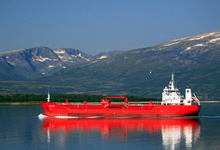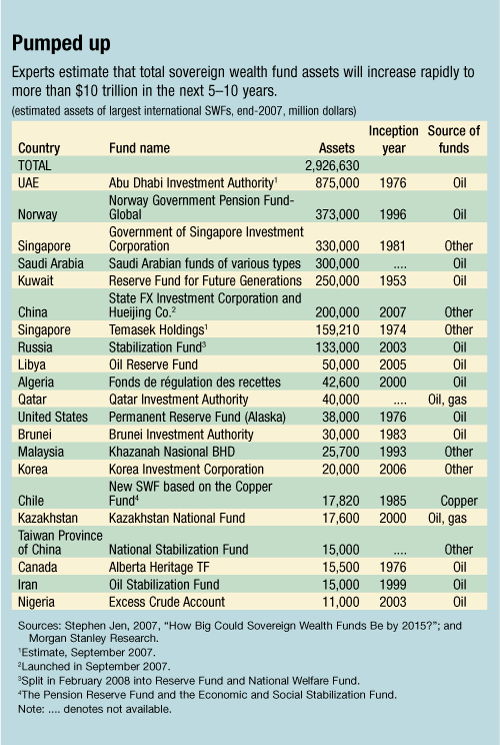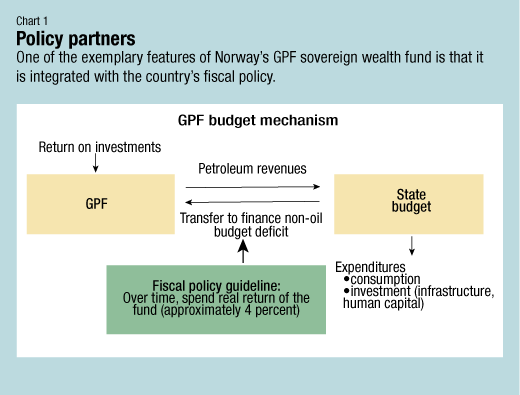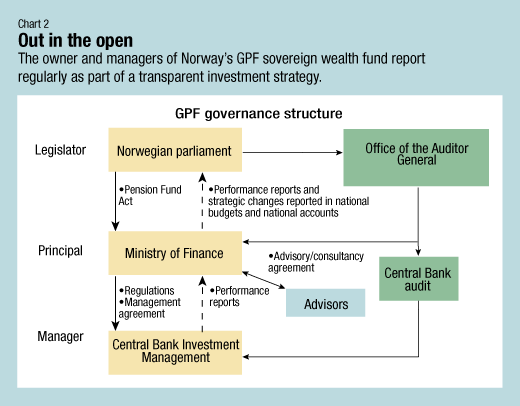
Typical street scene in Santa Ana, El Salvador. (Photo: iStock)
IMF Survey: Norway's Oil Fund Shows the Way for Wealth Funds
July 9, 2008
- Sovereign wealth funds under increased scrutiny
- IMF collaborating with wealth funds to design set of best practices
- Norway's government pension fund could serve as model
The Norwegian Oil Fund—recently renamed "the Government Pension Fund-Global"—is often cited as an exemplary sovereign wealth fund (SWF).

Oil tanker sails into Norwegian fjord: Norway's sovereign wealth fund is one of the largest and fastest-growing in the world (photo: Newscom)
STATE INVESTMENT INSTITUTIONS
This uniquely positions the fund as a model for and potentially important contributor to the new set of voluntary principles being developed for SWFs.
SWFs have been receiving increased scrutiny due to their growing presence in global financial markets. Their total assets are currently estimated at about $3 trillion (see table). Experts are expecting that their assets will increase rapidly to over $10 trillion in the next 5-10 years.

The growing importance and active investment strategies of SWFs are expected to affect the structure of international financial markets and asset pricing. On the one hand, their long horizons, lack of leverage, and absence of claims for imminent withdrawal of funds could help stabilize international financial markets by enhancing market liquidity and dampening asset price volatility.
On the other hand, their sheer size, rapid growth, and potential to abruptly change investment strategies, coupled with—in some cases—a lack of transparency and uncertainty surrounding the purpose of their investments, could exacerbate market uncertainty and thus increase volatility.
Voluntary code of conduct
In light of the concerns about SWFs, the IMF has been given a new mandate to facilitate the development of a set of voluntary principles for these funds. These principles would cover issues of public governance, transparency, and accountability. To this end, an International Working Group of SWFs (IWG) was formed at end-April 2008 and began work on the set of principles.
The new set of principles should help countries where SWFs are located to both strengthen their domestic policy frameworks and institutions and facilitate their macroeconomic and financial interests. The principles will also help ease concerns in countries receiving SWF investments and promote an open global monetary and financial system.
Lessons from Norway's experience
Norway's Government Pension Fund-Global (GPF) has a number of exemplary features that could serve as a model for other SWFs. The GPF is one of the largest and fastest-growing SWFs in the world, with total assets amounting to $373 billion at end-2007, or close to 100 percent of Norway's GDP. But size aside, the Norwegian GPF is mostly known for its features, which in many ways are considered best practices by international standards:
• The GPF's stated aim is to support government saving and promote an intergenerational transfer of resources. The fund facilitates the long-term management of the government's petroleum revenues. Given the expected population aging in Norway, it serves to pre-fund public pension expenditures.
• The GPF functions as a fiscal policy tool, which, together with the fiscal guideline, serves to limit government spending. The fund's capital consists of revenues from petroleum activities. The fund's expenditure is a transfer to the fiscal budget to finance the non-oil budget deficit. The fiscal guideline, introduced in 2001, calls for a limit on the non-oil structural central government deficit of around 4 percent of the assets of the GPF. Since 4 percent is the estimated long-run real rate of return, this rule amounts to saving the real capital of the fund and spending only its return (akin to an endowment fund).
• The fund is fully integrated into the budget (see Chart 1). The net allocation to the fund forms part of an integrated budgetary process. This process makes transparent the actual surplus of the fiscal budget and the state's use of petroleum revenues.

• It pursues a highly transparent investment strategy (see Chart 2). The Ministry of Finance—the fund's owner—reports regularly on the governance framework, the fund's goals, investment strategy and results, and ethical guidelines. The Central Bank—the fund's operational manager—publishes quarterly and annual reports on the management of the fund, including its performance and an annual listing of all investments. Detailed information on the fund's voting in shareholders' meetings is also published.
• Its assets are invested exclusively abroad. This strategy ensures risk diversification and good financial returns. Moreover, it helps to shield the non-oil economy from shocks in the oil sector, which can put pressure on the exchange rate (so-called "Dutch disease" effects). The GPF has small ownership shares in over 7,000 individual companies worldwide (the average ownership stake at end-2007 was 0.6 percent, against a maximum allowed of 5 percent).
• Its high-return, moderate-risk investment strategy has been hitting the mark. Currently, the fund is adjusting its portfolio to its new strategic benchmark of 60 percent of assets in equities and 40 percent in fixed income. There are plans to move gradually into real estate, to improve the risk-return tradeoff. The investment strategy has produced a healthy 4.3 percent average annual real return during the past decade.

• Its asset management is governed by a set of ethical guidelines. These guidelines, established by the Ministry of Finance, are based on internationally accepted principles developed by the United Nations and the Organization for Economic Cooperation and Development. Two policy instruments are used to promote the fund's ethical commitments. First, the fund exercises ownership rights in companies in which it invests with a view to promoting good and responsible conduct and respecting human rights and the environment when this is consistent with the fund's financial interests. Second, the Ministry of Finance can decide to avoid fund investments in specific companies whose practices constitute an unacceptable risk that the fund could become complicit in grossly unethical activities.
A role for Norway
The Norwegian GPF brings to the table several elements that could help design a set of successful voluntary principles for SWFs. The fund's role as a fiscal policy tool could guide other countries with nonrenewable resources in managing their policies in a sustainable way over the long run.
The GPF's highly transparent, yet competitive and successful asset management strategy—buying in markets whose values are falling to rebalance its portfolios—can serve as an example that open strategies not only produce financial results, but also enhance market liquidity and financial resource allocation and act as a stabilizing influence. Its experience with ethical guidelines provides further proof that commitment to the common good is not necessarily antagonistic to high returns.
Given their experience with managing the GPF, the Norwegian authorities have been openly supporting the IMF's work on SWFs and firmly back equal treatment of investors. They do not think that the investment activities of SWFs need to be more restricted than the activities of other investors, especially since, in contrast to hedge funds, SWFs have yet to be proven to be disruptive to markets. The Norwegians also caution that restricting investments of oil-related SWFs may reduce extraction, which could have a destabilizing effect on oil markets.
Comments on this article should be sent to imfsurvey@imf.org


